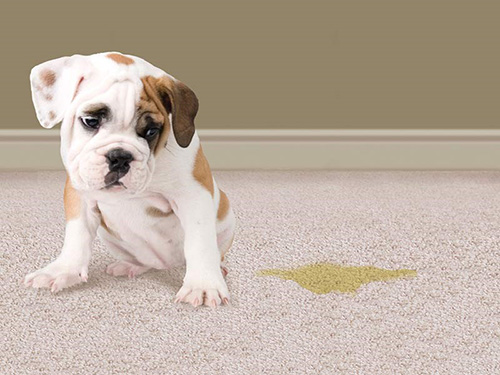 Pet urine can permanently stain your carpet. Pet stains can degrade air quality and create an unhealthy indoor environment. When urine is first deposited on a floor or fabric, it has a pH of about 5 or 6, which is on the acid side of the pH Scale. When pet stains are new, they are easier to remove from the carpet. When urine dries, it becomes “alkaline,” or has a high pH between 10 and 12 on the scale, making it more difficult to eliminate. The warm acidic nature of the urine provides an ideal breeding habitat for bacteria, which begin to proliferate almost immediately. In this first acid condition, the pee begins to oxidize and react with the carpet, causing a color change that will become permanent if the urine is not cleaned soon. Some of the color shift can be related to the strong ammonia that occurs as the urine undergoes bacterial and chemical changes. If left for days or weeks, depending on the fabric or floor type, it will modify the dye structure, resulting in permanent staining. Even if the soluble deposits are removed, the dye structure may have already been harmed.
Pet urine can permanently stain your carpet. Pet stains can degrade air quality and create an unhealthy indoor environment. When urine is first deposited on a floor or fabric, it has a pH of about 5 or 6, which is on the acid side of the pH Scale. When pet stains are new, they are easier to remove from the carpet. When urine dries, it becomes “alkaline,” or has a high pH between 10 and 12 on the scale, making it more difficult to eliminate. The warm acidic nature of the urine provides an ideal breeding habitat for bacteria, which begin to proliferate almost immediately. In this first acid condition, the pee begins to oxidize and react with the carpet, causing a color change that will become permanent if the urine is not cleaned soon. Some of the color shift can be related to the strong ammonia that occurs as the urine undergoes bacterial and chemical changes. If left for days or weeks, depending on the fabric or floor type, it will modify the dye structure, resulting in permanent staining. Even if the soluble deposits are removed, the dye structure may have already been harmed.
Urine odors are caused by two factors. The first is caused by bacteria, which thrive in dark, warm environments with a consistent food source. Amino acids are produced as a result of the bacteria’s development and breakdown of the urine. These complex chemical molecules frequently penetrate the fibers to the point of becoming part of the fiber. This is a difficult scenario. The waste components and gases produced by decaying urine emit an unpleasant stench. When dried urine is remoistened, it emits ammonia gas.
The second source of odor is chemical odor, which persists even after the bacteria have been eliminated. This explains why scents from pee require more than sanitization. When the relative humidity is high, urine emits additional odors. The salts and crystals that form as urine dries are hydrophilic and attract water. In humid months, dried urine is often easy to smell because the salts attract moisture, and the moisture evaporates, releasing a greater amount of odorous ammonia gas. To get rid of the stench, you must remove the urine salts from within and beneath the carpet. As a result, washing existing pee marks will NOT remove any accompanying odor. In fact, it may temporarily intensify the stink in the air.
Following a thorough inspection, our professionals will discuss possible cleaning choices and costs that would best meet your needs. However, we understand that money is an important consideration in making a decision, therefore, we will gladly provide you with an estimate for less aggressive treatment. While a less effective treatment will be less effective, it will save you a lot of money. For example, someone whose pets continue to mark the carpet may elect to use a less expensive, less complicated way of cleaning stains and odors because they will need to repeat it in the near future. These are our treatments:
Very minimal damage/spotting: enzyme treat and clean carpet using our usual cleaning technique.
Moderate damage/damage confined to a small area: Soak the carpet and pad in a solution that will break up the deposits, then do a comprehensive extraction. Finally, clean the carpet using our usual cleaning procedure.
Major damage/extensive contamination will necessitate cleaning both sides of the carpet, sealing the floor, and replacing the pad and tack strips. See the complete explanation under “Major Damage, below.
Recent Comments